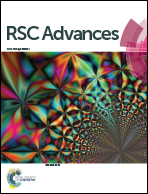Extraction of Pd(ii) and Pt(ii) from aqueous hydrochloric acid with 1,3-diaminocalix[4]arene: switching of the extraction selectivity by using different extraction modes†
Abstract
The extraction ability of 1,3-diaminocalix[4]arene (2: H2L) toward platinum group metals (PGMs) has been investigated, which revealed that 2 is able to extract Pd(II) and Pt(II) from hydrochloric acid via different extraction modes. The extraction species for Pd(II) and Pt(II) are [PdL] and [Pt2Cl6(H3L)2], respectively, as evidenced by equilibrium analysis and X-ray crystallography. In [PdL], the two phenoxide oxygens and two amino nitrogens of L2− coordinate to the Pd ion. On the other hand, in [Pt2Cl6(H3L)2], two anionic trichloro complexes PtCl3− are sandwiched between two H3L+, in which one amino nitrogen directly coordinates to a PtCl3− species and another protonated amino group forms an ion pair with another PtCl3−. Utilizing the different extraction modes, switching of the extraction selectivity has been achieved in the competitive extraction between Pd(II) and Pt(II) by varying the concentrations of H+ and Cl− in the aqueous phase. Finally, from the extracted organic phase, back-extraction of Pd(II) and Pt(II) was easily performed, respectively.
![Graphical abstract: Extraction of Pd(ii) and Pt(ii) from aqueous hydrochloric acid with 1,3-diaminocalix[4]arene: switching of the extraction selectivity by using different extraction modes](/en/Image/Get?imageInfo.ImageType=GA&imageInfo.ImageIdentifier.ManuscriptID=D0RA05339B&imageInfo.ImageIdentifier.Year=2020)


 Please wait while we load your content...
Please wait while we load your content...